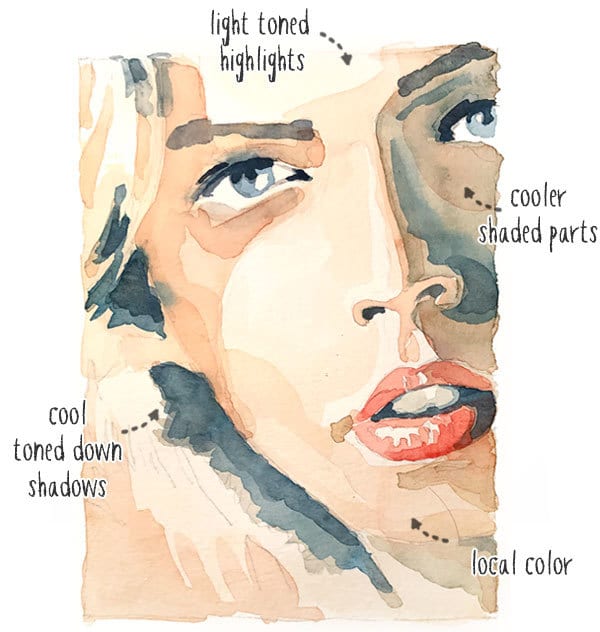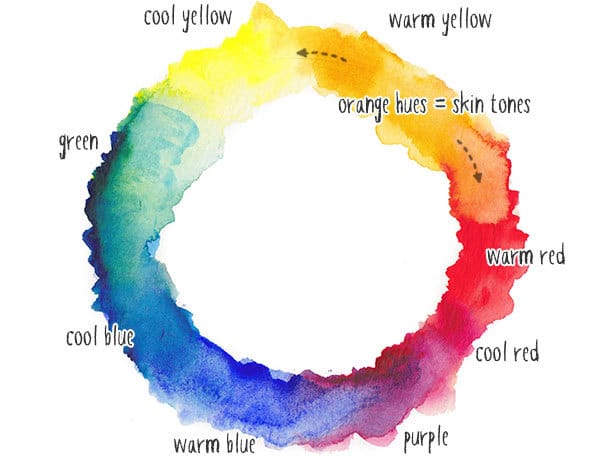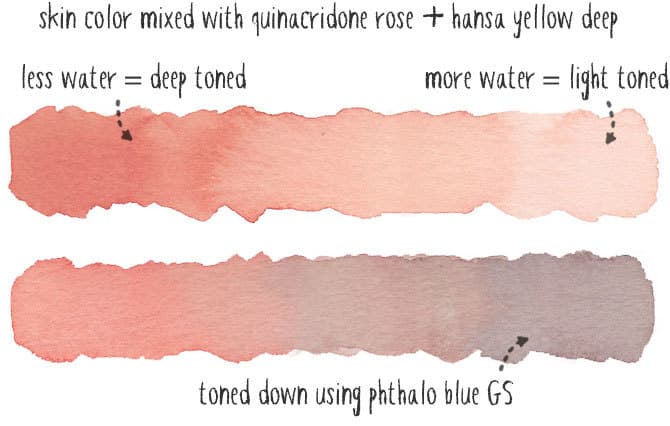What Colors To Use For Skin In Watercolor?
I have news for you lot… People's skin is never just one color. Unfortunately you lot tin can't just mix one generic pare tone in watercolor and pigment the whole of someone'south face, and there isn't only one magic color which suits all situations. The tone of someone's flesh varies enormously, and depicting this realistically in watercolor needs a basic understanding of colour mixing and light. Merely surprisingly, mixing watercolor skin tones is not that difficult!
And so how practice you mix realistic peel tones in watercolor? Begin by finding the local colour you want to mix, which is generally some variation of orange. With this information and the proper mixing method yous tin create whatsoever kind of flesh hue. To paint the shaded parts of skin, look closely to identify the right tonal values, and use a complementary color to tone down your colour mixes.
There is no right and incorrect manner to mix skin tones. But flesh colors exercise have some common colour characteristics, which ways that with the correct approach and a few basic mixing recipes you can exist up and painting faces in a flash!

Painting Realistic Watercolor Skin Tones
Whatsoever subject I'chiliad painting, whether it'south a portrait or a landscape or a even so life, I oftentimes refer dorsum to the same basic principles of painting in watercolors. Those two basics are color mixing and values. If you tin can work these things out so the remainder of the painting falls into place relatively easily. Funnily enough, your technique is much less of import.
This is why I'1000 fascinated past color mixing, and probably why I talk nearly values all the fourth dimension.
Very often you lot'll here artists talk near values or tones . Both these terms mean the same matter which is basically the darkness or lightness of any item hue. When I beginning started painting I completely ignored values! I wasn't enlightened how they could make such a big bear upon on my artwork. If yous become the values of your painting just right, y'all can create a much more realistic interpretation of your subject.
And so with this in mind, I observe that the best approach for mixing skillful skin colors for my paintings is as follows:
-
1
Place the local colour -
2
Utilize the right mixing method -
3
Make up one's mind the correct tonal value.
The local colour of flesh
A skillful starting signal for painting skin is to inquire "what is the local colour of flesh"?
Local colour is the innate color of an object, and it's the way nosotros tend to describe the generic colour of the things effectually usa. For case, the sky is "bluish", and an orange is… well… "orange"! You get the idea…
Almost of the fourth dimension the local colour of skin could be described as orangish in hue, which has a warm colour temperature.
But the colour of skin is influenced by many other factors and in particular by lighting. The local color will be modified depending on whether the subject is in light or shadow. And the colour of the shaded parts aren't always just a nighttime version of the local color. In fact in natural lighting, shadows volition accept a cool color appearance compared to the areas in light.

Then to create realistic skin tones, you can starting time by identifying the local color, and so create variations of this color to lucifer the calorie-free and dark tones of your subject.
But what methods tin can you use to practise this?
Skin Tone Mixing Method
A very useful tool for estimating which colors to mix is a watercolor color bicycle (this works whatsoever subject area your painting). If you lot've never painted ane of these then it tin can exist a very useful exercise for getting to know your paints.
It's adequately easy to detect your starting point for mixing skin tones using this device. If you lot take a look at a color wheel yous can begin to see that most flesh colors are going to fall somewhere in the range of the orangish hues. As you know this warm hue results from some kind of mix of red and yellow.

Then this is the fundamental starting bespeak for whatsoever skin tone.
You lot can start your color mixing by combining different yellows and reds, or even browns (which are substantially very nighttime reds). Use a test sheet to run across the results on paper.
Some parts of your painting might include some overnice vivid colors, but others will have very light toned pinks, yellows, browns and oranges. In watercolor painting you have a few useful methods for achieving this variation.
To lighten the tone of a color do the post-obit:
To tone down a color or increase information technology's value you can do 1 of these 2 options:
Take another look at the color bicycle. A complementary color is any color which is on the contrary side of the colour wheel. In our item case, the complement of orange is a absurd blue.

This means that once yous have selected a base of operations color for skin, you simply use dissimilar concentrations of that color. Then, one time you move into the shaded or shadow parts of the subject, you will demand to darken the tones further, and this is all-time done past adding a complementary color.
Your colour wheel is a useful tool to keep handy to help y'all with this mixing process.
When painting a portrait for example you want to add together depth to your paintings with a full range of values and interesting colors. Mixing mankind tones in this three step process:
-
1
Begin past mixing a local colour. -
2
Vary the proportions to accomplish a basic skin hue. -
3
Dilute the mixture to go a range of all the possible values from that mixture. -
4
To darken the tones further add a pocket-size amount of complementary bluish.

There you become! Yous're now a pare tone mixing expert.
Judging Skin Values
A color wheel is excellent for helping to mix colors, only in that location's another good tip you lot can try to help you judge the values of your subject area. Right values, or the lightness and darkness of the shapes you paint, will make a large divergence to the success of your painting.
An artist'south viewfinder is a cracking device to help you assess the correct values to paint. A viewfinder simply isolates a small part of your subject and so you can meliorate estimate the value of whatever one function. This works whether your working from real life or a reference photo.
You tin can make viewfinders quite easily from a piece of old watercolor paper with a pigsty cutting into it. Alternatively, I really like this composition finder which also includes a handy grayscale value chart (bank check the reviews on Amazon).

Watercolor Skin Tone Mixing Recipes
Allow'southward wait at some real examples and a few mixing recipes to make quick realistic looking pare.
There'southward more than one way to achieve the same hue. And it will largely depend on the palette of colors that you have bachelor to you. Y'all can use a whole range of analogous colors (colors which are close to each other on the color bike) to mix your "orangish" peel color. So just pick whatever warm or cool yellows, reds, and browns. The following are some typical combinations of colors that tend to produce proficient mankind hues.
Merely a quick note about the following mixing nautical chart. I use Daniel Smith watercolors because I love their handling properties and I detect the colors to be very vibrant. So the paint names below refer to that range of watercolors. (I've included links to Amazon for some of the paint colors which I think are the about important).
Yellowish ochre is 1 of the nearly popular colors in a skin tone mixing palette. Mixed with various reds such equally Pyrrol Ruby, Pyrrol Crimson, Burnt Sienna, and Burnt Umber. I also often use Hansa Yellow Deep, Raw Sienna and especially Quinacridone Rose (love that color)!
For toning downwards yous tin use a complementary absurd blue colour such as Phthalo Blue (GS), Cobalt Blue, or sometimes just Paynes Grey.
Whatsoever yous do, don't add Chinese white to lighten your tones. Just dilute your paint mix. I find Chinese white give a chalky appearance to the final paintings.

Skin Tone Techniques and Painting Tutorial
Glazing is my favorite technique for painting this kind of subject. You tin can build upwards your image niggling by little, starting with the lightest tones. Just past calculation multiple layers of colour you tin can add together depth and interesting texture to your work.

Let your imagination run free! Yous can also exaggerate and push color saturations across what would exist realistic and get some very artistic results!
Phew!
At present congratulate yourself for being a devoted artist and a expert skin tone mixer!

Source: https://www.watercoloraffair.com/watercolor-skin-tone-tutorial-how-to-mix-realistic-flesh-colors/
Posted by: casanovalaugge.blogspot.com


0 Response to "What Colors To Use For Skin In Watercolor?"
Post a Comment